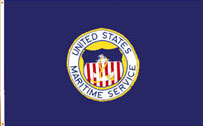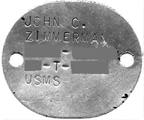U.S. Maritime Service: the Forgotten Service

U.S. Maritime Service Flag donated to the
by the Rev. George Cave, member of the Hoffman Island Radio Association."The United States shall have a merchant marine...[to] serve as a naval or military auxiliary in time of war or national emergency...[and] should be operated by highly trained and efficient citizens of the United States and that the United States Navy and the Merchant Marine of the United States should work closely together to promote the maximum integration of the total seapower forces of the United States...
"The Secretary may establish and maintain a voluntary organization for the training of citizens of the United States to serve on Merchant Marine vessels of the United States to be known as the United States Maritime Service...and to prescribe the uniform of such service and the rules governing the wearing and furnishing of such uniform....The ranks, grades, and ratings for personnel of the United States Maritime Service shall be the same as... for the personnel of the United States Coast Guard." Merchant Marine Act of 1936
In 1938, when a second World War was imminent, President Franklin D. Roosevelt realized that winning the war would require many ships to carry war supplies to the fronts. He ordered mass-production of Liberty ships and established the U.S. Maritime Service (USMS) to train the men needed to operate these ships. Joseph P. Kennedy, (father of President John F. Kennedy) was appointed as the first Chairman of the new Federal Maritime Commission in 1937 during which he laid the groundwork for the U.S. Merchant Marine. Kennedy became the United States Ambassador to Great Britain in 1938. Retired Admiral Emory Scott Land, USN, succeeded Kennedy as Chairman, and who also headed the War Shipping Administration. Admiral Land is the genius who put together the ship production, training of the men in the USMS, and operation of the vast fleet.
The U. S. Maritime Service was set up in 1938 under provisions of the Merchant Marine Act of 1936. Its purpose is to train officers and men for an adequate Merchant Marine. From July 1, 1941 to March 1, 1942 jurisdiction was under the U.S. Maritime Commission. From February 28, 1942 the U. S. Coast Guard, under Executive Order 9083, administered the training under the direction of the U.S. Maritime Commission. In July 11, 1942, Presidential Executive Order 9198 transferred operation of the Maritime Service to the War Shipping Administration, Admiral Emory Land, Administrator. A Division of Training was established under Admiral Land.
Train for Service in America's Mighty Merchant Marine
Be a Link in the Chain --- Production Line to the Firing Line
Men 17 1/2 To 50
Join the U.S. Maritime Service
(USMS Recruiting Bus, Toledo, Ohio. Photo courtesy of U.S. Maritime Administration)
USMS basic and advanced training bases were built across the nation:
- Port Hueneme, California (dedicated Aug. 30, 1941 to 1942)
- Avalon, California (Dec. 1942 to Oct 1945)
- Sheepshead Bay, New York (Sept. 1942 to Feb. 28, 1954)
- St. Petersburg, Florida (Nov. 1939 to March 31, 1950)
- Officer training school Fort Trumbull, Connecticut (Jan. 1, 1939 to May 1946)
- Training station Government Island, Alameda, California (Sept. 1938 to Feb. 6, 1943)
- Officer training school Alameda, California (Feb. 6, 1943 to Jan. 31, 1954)
- Basic Training and later Radio operator school Hoffman Island, New York (Sept. 7, 1938 to Oct. 1945)
- Radio operator school Gallups Island, (Boston Harbor) Massachusetts (July 1940 to Oct. 1945)
- Huntington, New York, Radio Training Station (?)
The USMS was first established under the Coast Guard and later supervised by U.S. Navy officers. Many of its first recruits in 1938 were from the Civilian Conservation Corps (CCC). Men, caught up in the patriotic fervor of the time, came forward to serve in the fledgling U.S. Maritime Service. There were 37 Official U.S. Government Recruiting Offices set up around the country. Radio and newspaper ads brought in the thousands of young patriotic men, as young as 16 years of age, from every State who answered their country's call to serve. Some Offices were located next to Navy and Coast Guard Offices. Many men were sent to the USMS by U.S. Navy and Coast Guard recruiters who said, "That's where your service is needed." The USMS was the only racially integrated service of the time. African-Americans
Thousands of active and retired mariners, Navy, and Coast Guardsmen were pressed into duty to serve as administrators and instructors in the U.S. Maritime Service. They believed then, and still believe today, they joined a uniformed, armed service! Many of these were cheated out of service and retirement time. [They are still seeking veteran status from the Air Force Secretary. The USMS was an official U.S. Government organization, while the WASPs and most of the other groups who received veteran status were either under contract to the Government or unofficial organizations. WASP instructors and women who failed the training program received veteran status.]
The USMS took over 250,000 raw recruits and turned them into fighting mariners. They taught them operation of anti-aircraft guns and cannon. They taught navigation, engine operation and maintenance, and deck operations aboard training vessels that operated in hazardous waters subject to mines and attack by German and Japanese submarines.
The United States Maritime Service trained men for the U.S. Merchant Marine, and U.S. Army Transport Service to transport supplies and personnel in the largest fleet of freighters, tankers, and transports in history to bases all over the world for U.S. and Allied forces. Men at the fronts depend on this important service for bombs, gasoline, shells, ammunition, food, guns, vehicles, planes, medicine, and other materials for warfare.The ships of the U.S. Merchant Marine and U.S. Army Transport Service were on the frontline as soon as they left their docks and harbors. The enemy mined some harbors, and submarines and raiders waited for their prey outside of the harbors, especially on the East and Gulf coasts of the United States.
When the huge Sheepshead Bay Training Station, in Brooklyn, N.Y., was opened in 1942 President Franklin D. Roosevelt sent his personal greetings,
"It is with a feeling of great pride that I send my heartiest congratulations and best wishes to the officers and men of the new U. S. Maritime Service Training Station at Sheepshead Bay, New York. Ten thousand apprentice seamen in training at one station is a magnificent achievement, and the entire country joins me in wishing you every success and in paying tribute to you men of the Merchant Marine who are so gallantly working and fighting side by side with our Army and Navy to defend the way of life which is so dear to us all." [emphasis added]
Roosevelt Praises Maritime Service, New York Times, December 13, 1942
The photo (above), taken in 1943, shows Lindell Jenkins [1925-2000] of Texas, at age 17, in his U.S. Maritime Service uniform.U. S. Navy Air Transport flew approximately 250 USMS personnel each month between Miami, Fla., and Panama Canal Zone. War Shipping Administration Press Release
"Self-improvement is the Patriotic Duty of Every Merchant Seaman" stated the War Shipping Administration in a pamphlet encouraging mariners to take Upgrade courses at U.S. Maritime Service schools.
The USMS Training Bases were disbanded in 1954, the servicemen sent home with a "release from duty" to be all but forgotten by the country they served. Today federal agencies act as if the branch never even existed. The U.S. Maritime Service disappeared in the dust bins of the National Archives. [The U.S. Merchant Marine Academy and the State Maritime Academies are still part of the U.S. Maritime Service.]


